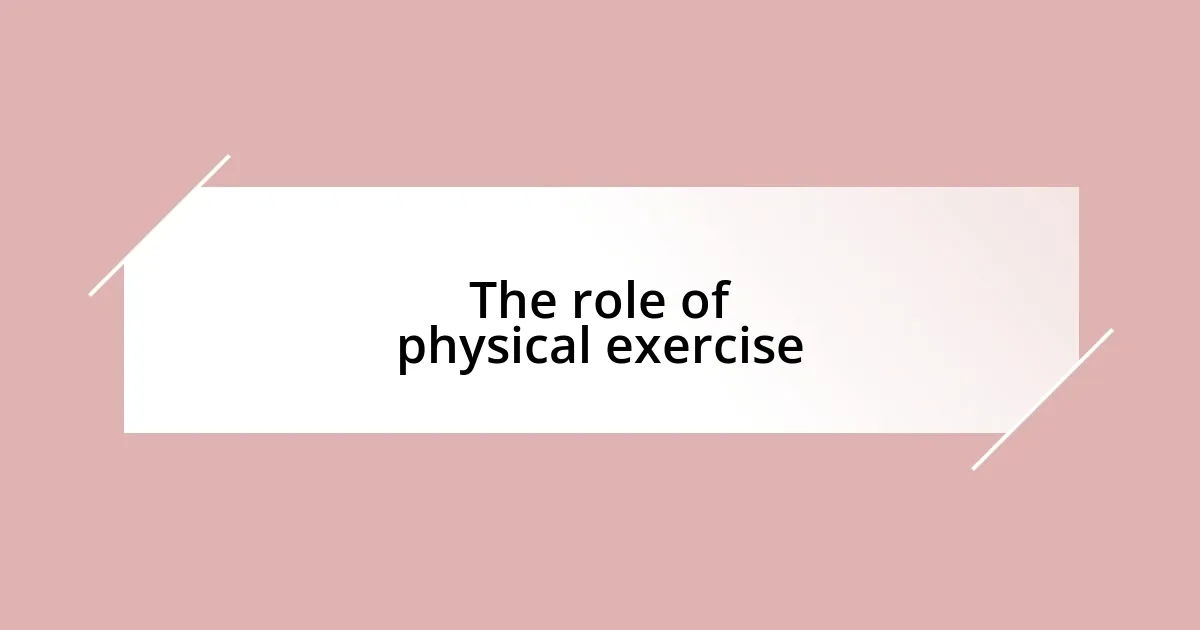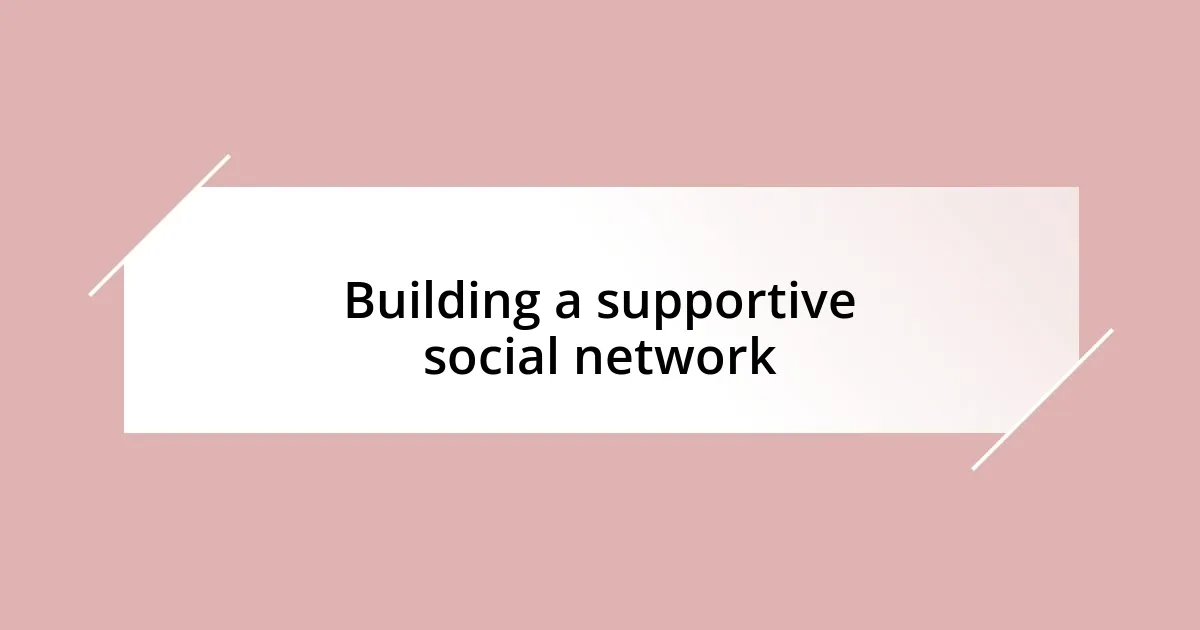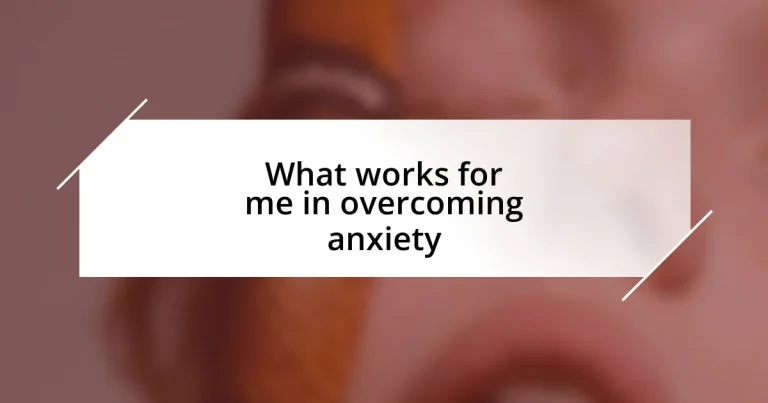Key takeaways:
- Understanding personal anxiety triggers, such as crowded places and stress factors, is crucial for effective management.
- Practical strategies like grounding exercises, maintaining a consistent routine, and keeping an anxiety journal can significantly help in daily anxiety management.
- Mindfulness techniques, including body scan meditation and focused breathing, foster relaxation and emotional awareness.
- Building a supportive social network and seeking professional help, including therapy and medication, are vital components in managing anxiety effectively.

Understanding anxiety triggers
Anxiety triggers can vary widely from person to person. For me, it’s often crowded places. I once found myself feeling overwhelmed during a bustling event, heart racing, and palms sweaty; it made me wonder, have you experienced something similar?
I’ve also noticed that my triggers can shift based on other factors, like lack of sleep or stress at work. Have you ever found that your anxiety ramps up when you’re juggling too many responsibilities? I can certainly relate to that feeling; it’s like a snowball effect, where one little stressor gathers momentum and suddenly feels unmanageable.
Understanding these triggers is essential for managing my anxiety. When I began to recognize them—whether it’s a specific situation or even certain people—I felt empowered to navigate my emotions better. It’s as if identifying the monster under the bed helps me realize it’s not so scary after all! Does that resonate with you?

Practical strategies for daily life
Finding practical strategies to manage anxiety in daily life can make a significant difference. One of my go-to techniques is grounding exercises. I remember a time at work when my anxiety surged before a presentation. I took a moment to connect with my surroundings, focusing on five things I could see, four I could touch, three I could hear, two I could smell, and one I could taste. This simple exercise calmed my racing thoughts and brought me back to the present moment.
Incorporating a consistent routine also plays a crucial role in managing my anxiety. I’ve found that starting my day with a short morning ritual—whether it’s sipping herbal tea while journaling or doing a few stretches—sets a positive tone for the day. It’s like laying a strong foundation; without it, the rest of the day can feel shaky and unpredictable. Have you ever tried a morning routine? It can really transform your mindset.
Another strategy that has worked wonders for me is keeping an anxiety journal. I jot down my thoughts and feelings when anxiety strikes, and it often helps me process what’s happening inside my head. Once, during a particularly anxious week, I noticed a pattern in my entries; they all related to feelings of inadequacy. Writing it down gave me clarity and reminded me that I’m not alone in this journey. Have you thought about reflecting on your feelings in a similar way? It can be a powerful tool for self-discovery.
| Strategy | Description |
|---|---|
| Grounding Exercises | A technique to stay present by focusing on your senses. |
| Consistent Routine | Establishing a morning ritual to create a positive mindset. |
| Anxiety Journal | Writing down thoughts and feelings to gain clarity and process emotions. |

Mindfulness techniques for anxiety relief
Mindfulness techniques have been pivotal in my journey toward managing anxiety. One particular practice I cherish is the body scan meditation. I recall lying in my bed one evening, feeling an anxious knot in my stomach. I decided to close my eyes and slowly focus on each part of my body, starting from my toes and moving upward. As I consciously relaxed each muscle, I could feel the weight of my worries begin to lift. It’s a simple yet profound way to reconnect with myself and ease tension.
Another mindfulness practice that resonates with me is focused breathing. During stressful moments, I often find myself returning to this technique. I remember being in a long line at the grocery store, feeling my unease creeping in. I took a deep breath in for four counts, held it for four, then exhaled for six. By the time I reached the cashier, my heart rate had settled, and I was rooted in the moment rather than lost in a spiral of anxious thoughts.
Here are some mindfulness techniques that can help in relieving anxiety:
- Body Scan Meditation: A method focusing on relaxing each body part individually to promote awareness and calming sensation.
- Focused Breathing: A technique where you concentrate on your breath to anchor yourself, helping to reduce racing thoughts.
- Mindful Walking: Taking a walk while paying attention to your surroundings, and how your feet connect with the ground, allows for a perspective shift.
- Gratitude Journal: Writing down three things you’re thankful for each day encourages positivity and can reduce anxiety.
- Visualization: Imagining a peaceful scene or a stress-free environment fosters relaxation and combats anxiety.
I have found that incorporating these techniques into daily life not only helps in moments of panic but gradually reinforces a state of calmness. Have you experimented with any of these methods? They can truly create a sense of grounding.

The role of physical exercise
Physical exercise has become a cornerstone in my approach to tackling anxiety. I recall one particularly overwhelming day when I felt suffocated by worries, so I laced up my running shoes and hit the pavement. As I moved, the rhythm of my feet on the ground and the fresh air filling my lungs created a powerful shift in my mindset. Have you ever experienced that moment when a simple run can clear your head? It’s amazing how physical activity can release those endorphins that elevate your mood.
Additionally, the sense of accomplishment that comes from completing a workout can’t be overstated. I remember finishing a challenging strength-training session, feeling that rush of pride for pushing through despite my anxiety. In those moments, I recognize the strength within me—not just physically but mentally as well. Have you considered how your physical capabilities can reflect your mental resilience? It’s something I’ve found incredibly empowering each time I step into the gym or take a fitness class.
Moreover, exercise provides an excellent opportunity for mindfulness. When I engage in activities like yoga or cycling, I immerse myself in the present moment, relishing the sensations of my body moving. There was a time I attended a yoga class during a particularly stressful week, and the focus on my breath and movements brought a tranquility I hadn’t felt in days. Isn’t it remarkable how combining physical activity with mindfulness can create a haven of calm amidst chaos? Each session teaches me to be gentle with myself, fostering not only physical health but emotional well-being.

Building a supportive social network
Building a supportive social network has been a game-changer for me in facing anxiety. I can vividly recall a time when I felt overwhelmed with worries during a particularly tough week. I reached out to a friend, and we ended up talking for hours. Just knowing that someone was there to listen and understand lightened my mental load. Have you ever realized how much a single conversation can shift your perspective?
What I’ve noticed is that the quality of my connections matters more than the quantity. Surrounding myself with people who genuinely care and understand anxiety makes an incredible difference. I remember when a close friend invited me to join a support group. Initially hesitant, I was surprised at how comforting it felt to share experiences with others who understood my struggles. This sense of belonging and community validated my feelings and reinforced my courage. Don’t you think that shared experiences can be incredibly powerful?
Additionally, I often find that simply engaging in activities with loved ones brings an unexpected solace. One Saturday, my brother and I spent the afternoon painting together. As we laughed and created, the chaos in my mind began to quiet down. It reminded me that it’s those moments of connection that foster resilience. Have you thought about how spending time with loved ones can transform your mindset? For me, building a supportive network is a continuous journey, but it’s one I cherish deeply.

Professional help and therapy options
Seeking professional help has been a pivotal step in my journey to manage anxiety. I remember the first time I sat down in a therapist’s office, feeling a mix of anticipation and fear. The moment I began to unpack my thoughts with a trained professional, it felt like lifting a heavy weight off my chest. Have you ever had that feeling of relief when someone simply listens? It can truly be a lifeline when navigating those tangled emotions.
Cognitive-behavioral therapy (CBT) has been particularly impactful for me. This form of therapy focuses on identifying and challenging negative thought patterns, which I found incredibly helpful. I distinctly recall a session where my therapist guided me through reframing my anxious thoughts. When I learned to replace “I can’t handle this” with “I can handle everything one step at a time,” I felt a surge of empowerment. Isn’t it fascinating how a shift in mindset can change everything?
Moreover, medication was something I initially hesitated to consider, but I decided to have an open conversation with my doctor. It turns out, certain medications can offer significant support alongside therapy. The first few weeks were a bit rocky, but as I adjusted, I noticed a clearer perspective and a reduction in anxiety. I’ve come to appreciate that managing anxiety can sometimes require a multi-faceted approach. Don’t you think it’s vital to explore different avenues for relief? In my experience, combining therapy and medication has created a well-rounded support system for me.

Long-term management and coping skills
Long-term management of anxiety often hinges on developing effective coping skills that become integral to daily life. For me, incorporating mindfulness practices into my routine has been incredibly beneficial. I remember a day when anxiety seemed to envelop me. Instead of succumbing to the frenzy, I took a moment to breathe deeply and focus on the present. This simple practice allowed me to reclaim my mental space and reminded me that I have the power to control my reactions to anxiety. Have you ever noticed how just a few moments of awareness can create a calm oasis amid chaos?
Another strategy that has proven useful is maintaining a consistent exercise routine. I find that when I make physical activity a priority, it not only boosts my mood, but also provides a healthy release for stress. I vividly recall returning from a jog one afternoon, feeling a surge of energy and clarity enveloping my mind. It’s fascinating how endorphins from exercise can shift your outlook, isn’t it? Incorporating movement into my life has made me resilient against anxiety, helping me tackle daily challenges with a renewed sense of hope.
Lastly, journaling has emerged as a powerful tool for me in long-term anxiety management. By putting my thoughts on paper, I create a safe space to explore my feelings and track my progress. I remember flipping through old entries and seeing how far I’ve come. It always astonishes me how articulating fears can help dismantle their power. Have you ever tried writing down your thoughts? It can be like holding up a mirror to your mind, revealing truths that often get overshadowed by anxiety.














